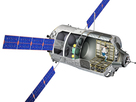Launch of the ATV
ATV Johannes Kepler on its way to the ISS
ATV Johannes Kepler was launched on a specially modified launcher, the Ariane 5ES, at 22:50 CET on 16 February 2011 from Europe's spaceport in French Guiana. The second space cargo carrier in the ATV programme, it is now en route to the International Space Station (ISS).
 © Arianespace
|
Launch of the ATV on board Ariane 5ES
Article Content
- » 1 - On its way to the ISS
- » 2 - ATV – a success story
On its way to the ISS
The Automated Transfer Vehicle Johannes Kepler was launched on a specially modified launcher, the Ariane 5ES, at 22:50 CET on 16 February 2011 from Europe's spaceport in French Guiana. The second space cargo carrier in the Automated Transfer Vehicle (ATV) programme, it is now en route to the International Space Station (ISS). The German contribution to the ATV programme is managed by the German Aerospace Center (Deutsches Zentrum für Luft- und Raumfahrt; DLR) through its Space Agency. This first launch of the year was also the Ariane's 200th. In addition to food, dry cargo, propellants and gases, the unmanned ATV-2 is carrying the German GeoFlow II experiment, which scientists will use to study processes in the Earth's mantle.
The space cargo carrier separated from the upper stage of the Ariane launcher at an altitude of 260 kilometres, and is approaching the ISS autonomously, using GPS, radar and optical sensors. The ATV-2 will then dock automatically with the Russian service module Zvezda, where it will remain for at least three months. On 4 June at the earliest, the transporter will undock from the ISS and burn up in Earth's atmosphere during a controlled re-entry. The second ATV carries a total payload of 7090 kilograms, including 5386 kilograms of propellant and 100 kilograms of air. The remaining freight consists of a variety of items needed by the astronauts, as well as replacement parts and experiments.
One of the experiments on ATV Johannes Kepler is the German instrument GeoFlow II, to be installed in the Columbus laboratory. GeoFlow II is a successor of the experiment GeoFlow, which was installed on the ISS in 2008. Scientists from Brandenburg University of Technology Cottbus (Brandenburgische Technische Universität; BTU) plan to use it to simulate convection currents in the Earth's mantle. One of the experiment's objectives is to better understand heat transfer and flow patterns of magma. The research is scheduled to begin in spring 2011, and will continue until early summer.
The space cargo carrier separated from the upper stage of the Ariane launcher at an altitude of 260 kilometres, and is approaching the ISS autonomously, using GPS, radar and optical sensors. The ATV-2 will then dock automatically with the Russian service module Zvezda, where it will remain for at least three months. On 4 June at the earliest, the transporter will undock from the ISS and burn up in Earth's atmosphere during a controlled re-entry. The second ATV carries a total payload of 7090 kilograms, including 5386 kilograms of propellant and 100 kilograms of air. The remaining freight consists of a variety of items needed by the astronauts, as well as replacement parts and experiments.
One of the experiments on ATV Johannes Kepler is the German instrument GeoFlow II, to be installed in the Columbus laboratory. GeoFlow II is a successor of the experiment GeoFlow, which was installed on the ISS in 2008. Scientists from Brandenburg University of Technology Cottbus (Brandenburgische Technische Universität; BTU) plan to use it to simulate convection currents in the Earth's mantle. One of the experiment's objectives is to better understand heat transfer and flow patterns of magma. The research is scheduled to begin in spring 2011, and will continue until early summer.
Launch of the ATV
ATV Johannes Kepler on its way to the ISS
ATV Johannes Kepler was launched on a specially modified launcher, the Ariane 5ES, at 22:50 CET on 16 February 2011 from Europe's spaceport in French Guiana. The second space cargo carrier in the ATV programme, it is now en route to the International Space Station (ISS).
 © Arianespace
|
Launch of the ATV on board Ariane 5ES
Article Content
- » 1 - On its way to the ISS
- » 2 - ATV – a success story
On its way to the ISS
The Automated Transfer Vehicle Johannes Kepler was launched on a specially modified launcher, the Ariane 5ES, at 22:50 CET on 16 February 2011 from Europe's spaceport in French Guiana. The second space cargo carrier in the Automated Transfer Vehicle (ATV) programme, it is now en route to the International Space Station (ISS). The German contribution to the ATV programme is managed by the German Aerospace Center (Deutsches Zentrum für Luft- und Raumfahrt; DLR) through its Space Agency. This first launch of the year was also the Ariane's 200th. In addition to food, dry cargo, propellants and gases, the unmanned ATV-2 is carrying the German GeoFlow II experiment, which scientists will use to study processes in the Earth's mantle.
The space cargo carrier separated from the upper stage of the Ariane launcher at an altitude of 260 kilometres, and is approaching the ISS autonomously, using GPS, radar and optical sensors. The ATV-2 will then dock automatically with the Russian service module Zvezda, where it will remain for at least three months. On 4 June at the earliest, the transporter will undock from the ISS and burn up in Earth's atmosphere during a controlled re-entry. The second ATV carries a total payload of 7090 kilograms, including 5386 kilograms of propellant and 100 kilograms of air. The remaining freight consists of a variety of items needed by the astronauts, as well as replacement parts and experiments.
One of the experiments on ATV Johannes Kepler is the German instrument GeoFlow II, to be installed in the Columbus laboratory. GeoFlow II is a successor of the experiment GeoFlow, which was installed on the ISS in 2008. Scientists from Brandenburg University of Technology Cottbus (Brandenburgische Technische Universität; BTU) plan to use it to simulate convection currents in the Earth's mantle. One of the experiment's objectives is to better understand heat transfer and flow patterns of magma. The research is scheduled to begin in spring 2011, and will continue until early summer.
The space cargo carrier separated from the upper stage of the Ariane launcher at an altitude of 260 kilometres, and is approaching the ISS autonomously, using GPS, radar and optical sensors. The ATV-2 will then dock automatically with the Russian service module Zvezda, where it will remain for at least three months. On 4 June at the earliest, the transporter will undock from the ISS and burn up in Earth's atmosphere during a controlled re-entry. The second ATV carries a total payload of 7090 kilograms, including 5386 kilograms of propellant and 100 kilograms of air. The remaining freight consists of a variety of items needed by the astronauts, as well as replacement parts and experiments.
One of the experiments on ATV Johannes Kepler is the German instrument GeoFlow II, to be installed in the Columbus laboratory. GeoFlow II is a successor of the experiment GeoFlow, which was installed on the ISS in 2008. Scientists from Brandenburg University of Technology Cottbus (Brandenburgische Technische Universität; BTU) plan to use it to simulate convection currents in the Earth's mantle. One of the experiment's objectives is to better understand heat transfer and flow patterns of magma. The research is scheduled to begin in spring 2011, and will continue until early summer.






